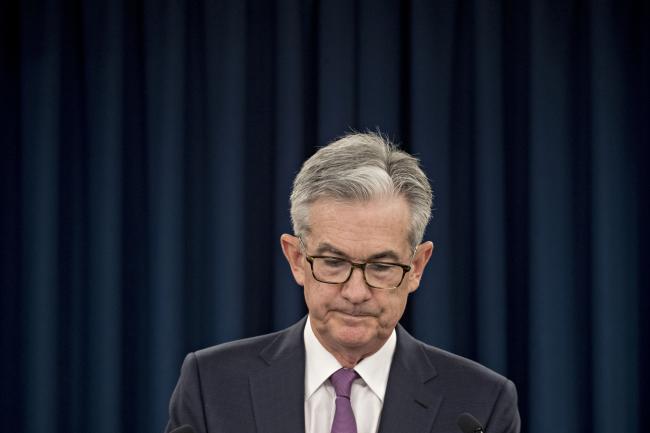(Bloomberg) -- Former Federal Reserve Chairman Alan Greenspan once remarked that uncertainty is the “defining characteristic’’ of monetary policy – and he never had to deal with President Donald Trump.
In a reversal of policy, current Fed chief Jerome Powell on Wednesday opened the door to an interest rate cut as early as next month.
He made clear that uncertainty -- primarily about the president’s trade battles and their potentially corrosive impact on the U.S. and other economies -- was a major factor behind the shift, along with weaker-than-wanted inflation.
“While the baseline outlook remains favorable, the question is whether these uncertainties will continue to weigh on the outlook and thus call for additional monetary policy accommodation,’’ he told reporters after the Fed left rates unchanged.
Those uncertainties may not lift any time soon. While Trump is slated to meet Chinese President Xi Jinping later this month at the G-20 summit in Japan to discuss their ongoing trade war, the president’s proclivity to abruptly shift his tariff strategy could keep corporate decision makers on edge for a while. It’s also put the European Central Bank on alert for a potential easing of its monetary policy.
The trade tensions “are undercutting confidence and that is slowly spreading throughout the economy,’’ said Ethan Harris, head of global economics research at Bank of America Merrill Lynch (NYSE:BAC). “The tariff termites are chewing quietly under the surface.’’
Trump, for his part, has been far from quiet. He’s repeatedly criticized Powell and the Fed for keeping credit too tight and complained that the central bank is undercutting efforts to win his battles with China and other trading partners.
The president asked White House lawyers earlier this year to explore options for removing Powell as Fed chair, and Trump told confidants as recently as Wednesday that he believes he has the authority to replace him, Bloomberg reported this week.
Powell, who’s vowed to protect the Fed’s independence, said on Wednesday that he expects to get a clearer a read on whether the economy needs easier credit “in the very near term.’’ He also refused to rule out the possibility of a half percentage point reduction.
“That’s just something we haven’t really engaged with yet,’’ he said when asked about a 25 or 50 basis point move. “It will depend very heavily on incoming data and the evolving risk picture as we move forward.’’
“You can’t rule out a 50 basis point move in July,” said John Herrmann, director of U.S. rate strategy at MUFG Securities Americas. “He sounded at least willing to entertain the idea, which is more aggressive than markets were thinking.’’
The Fed’s statement Wednesday and Powell’s remarks in the subsequent press conference were well received by investors, with both stock and bond prices rising.
Inflation Muted
The Fed can afford to be aggressive because inflationary pressures are muted. Indeed, Powell suggested that weak price pressures could be a reason on their own for the central bank to reduce rates.
“We are well aware that inflation weakness that persists even in a healthy economy could precipitate a difficult-to-arrest downward drift in longer run inflation expectations,’’ he said.
The Fed has failed to convincingly hit its 2% inflation objective since 2012. What’s more, inflation expectations, particularly in financial markets, have fallen recently and Fed officials themselves marked down their forecast of price rises this year, to 1.5%, from 1.8% in March.
Powell also suggested that the labor markets might not yet be tight enough to generate the sort of the wage-driven rise in inflation that the Fed is seeking.
While salaries are increasing, they’re not growing “at a pace that would provide much upward impetus to inflation,’’ he said.
That’s despite the fact unemployment is near a half century low of 3.6%.
The Federal Open Market Committee’s vote on Wednesday to leave rates unchanged -- in a 2.25% to 2.5% range -- was not unanimous, with St. Louis Fed President James Bullard seeking a quarter-point rate cut. His vote marked the first dissent of Powell’s 16-month tenure as chairman.
While officials were divided on the path for policy -- eight of 17 penciled in a reduction by the end of the year as another eight saw no change and one forecast a hike -- Powell said most agreed that the possibility of a move has risen.
The risks “have called a number of us to write down rate cuts, and a number of those who haven’t to see that the case has strengthened,” he said.
“The main message we heard from Powell’s press conference was that the only argument against cutting rates today was a desire to wait a little to learn a lot,’’ JPMorgan Chase & Co (NYSE:JPM). chief U.S. economist Michael Feroli said in a note to clients.
“The burden is on the data looking quite solid and trade policy turning more growth favorable to defuse the case for cutting at the next meeting,” he added.
(Updates with Trump exploring options to replace Powell in eighth paragraph.)
